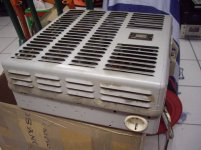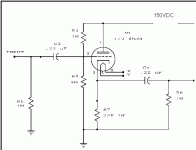Well I finished my stereo buffer preamp using the 6DJ8,and the Compactron regulated power supply, it simply sounds beautiful, super S/N stats, but recently I decided to try a 6922EH,plugged it in powered up and noticed a buzz, with the 100k pot at maximum resistance. But if I turn up the volume it disappears. Is it simply the pot resistance, supply voltage not sure what's causing this. I will try later to post schematic, on iPhone right now. BTW it is Steve Bench's buffer curcuit.
Well I finished my stereo buffer preamp using the 6DJ8,and the Compactron regulated power supply, it simply sounds beautiful, super S/N stats, but recently I decided to try a 6922EH,plugged it in powered up and noticed a buzz, with the 100k pot at maximum resistance. But if I turn up the volume it disappears. Is it simply the pot resistance, supply voltage not sure what's causing this. I will try later to post schematic, on iPhone right now. BTW it is Steve Bench's buffer curcuit.
I haven't looked into your particular situation, however, the information I received from EH is that their variation of the 6922 is modeled on the Russian 6N23P. Not sure at this time if if makes a difference. May be a starting point.
What happens when you put back the 6DJ8? Some people swap 6DJ8s for 6922s and vice versa though I advise against this. I spent many many hours tracking down a buzz in an ARC power amp only to solve the problem by refitting a 6DJ8 in place of a 6922 that the owner had fitted.
What happens when you put back the 6DJ8? Some people swap 6DJ8s for 6922s and vice versa though I advise against this. I spent many many hours tracking down a buzz in an ARC power amp only to solve the problem by refitting a 6DJ8 in place of a 6922 that the owner had fitted.
It returns to normal. No buzz, zero noise.
I haven't looked into your particular situation, however, the information I received from EH is that their variation of the 6922 is modeled on the Russian 6N23P. Not sure at this time if if makes a difference. May be a starting point.
You may be right, the EH looks like a completely different tube than my NOS.
My understanding is that 6922 is equivalent to E88CC, while 6DJ8 is equivalent to ECC88. They are almost equivalent, apart from different heater current. Modern versions of these may well mix up the characteristics.
ECC88=E88CC=E188CC=CCa=6DJ8=6922=6H23П
In terms of electrical characteristics, these tubes are nearly almost the same. For a simple audio amplifier you won't notice any difference between those tubes. And if you do, then the tube has a defect.
When you want to know the difference, look at the pics in the attachement. Thats an antenna amplifier for VHF and UHF for a multi-story building (source: Dampfradioforum • Thema anzeigen - Antennenverstärker Fuba um 1960). This was installed about 1960 and used E88CC. When it was removed in 2011 it still worked flawlessly. (The only problem being that this baby constantly cosumes about 75W !) A normal ECC88 maybe wouldn't have survived over 50 years. And that's is the difference.
In terms of electrical characteristics, these tubes are nearly almost the same. For a simple audio amplifier you won't notice any difference between those tubes. And if you do, then the tube has a defect.
When you want to know the difference, look at the pics in the attachement. Thats an antenna amplifier for VHF and UHF for a multi-story building (source: Dampfradioforum • Thema anzeigen - Antennenverstärker Fuba um 1960). This was installed about 1960 and used E88CC. When it was removed in 2011 it still worked flawlessly. (The only problem being that this baby constantly cosumes about 75W !) A normal ECC88 maybe wouldn't have survived over 50 years. And that's is the difference.
Attachments
6DJ8 comes first ( was designed for Tek oscilloscopes AFAIK). Russian 6N23P is a 6DJ8 clone. Was used in oscilloscopes as well.I haven't looked into your particular situation, however, the information I received from EH is that their variation of the 6922 is modeled on the Russian 6N23P. Not sure at this time if if makes a difference. May be a starting point.
I am running 6922 now (Graaf GM 13.5) they are nice, but Amperex PQ 6DJ8 claimed to be the most nice sounding ones. Otherwise 6922 is the right choice.
Some audiophiles like 6N1P but it requires more filament current about 1A.
EH6922
One of the main differences of the the new production EH6922 compared to NOS 6922, 6DJ8 is the heater-to-cathode voltage of +/-200V. The max plate voltage of the EH6922 is 300V which is about 50V higher than the NOS 6922.
The 6N1P is a completely different tube.
One of the main differences of the the new production EH6922 compared to NOS 6922, 6DJ8 is the heater-to-cathode voltage of +/-200V. The max plate voltage of the EH6922 is 300V which is about 50V higher than the NOS 6922.
The 6N1P is a completely different tube.
I think I will try some different brands of the 6922 and see what
The results are, EH is new, and I tested it as good, but my tester
Is limited, so their could be some other defect, I'm not aware of.
The results are, EH is new, and I tested it as good, but my tester
Is limited, so their could be some other defect, I'm not aware of.
Have you grounded the internal shield?
yes the shield is grounded.
Are the heaters floating or not?
Try biasing them at +30V or something like that..
I've thought about that,but isn't the H-K voltage greater with the 6922EH?
I've thought about that,but isn't the H-K voltage greater with the 6922EH?
Yes, but that doesnt mean it's les prone to HUMMM I think.
With this tube family, a grid-stopper resistor is almost mandatory and a cathode stopper is often helpful, especially with the 100% feedback of a cathode follower. You also need local bypassing. Intermittent oscillations can manifest as all sorts of noises and odd effects.
I have ordered various other brands of 6DJ8's. The tube I'm using now is a NOS made in Japan,it's a nice sounding tube. The 6922 sounds just fine as long as I keep the volume control from the zero setting it's dead quiet!!,as soon as I turn the volume all the way down,I get that pesky buzz!!!
What you have there is a marginally stable (or perhaps not so marginal) circuit. The buzz with certain tubes is likely a gross symptom- what you need to do is address the root cause. Fortunately, the likely cure only involves 25 cents worth of parts.
What you have there is a marginally stable (or perhaps not so marginal) circuit. The buzz with certain tubes is likely a gross symptom- what you need to do is address the root cause. Fortunately, the likely cure only involves 25 cents worth of parts.
Would a lower value pot at the input help?
- Status
- Not open for further replies.
- Home
- Amplifiers
- Tubes / Valves
- 6922, a 6DJ8 replacement??


